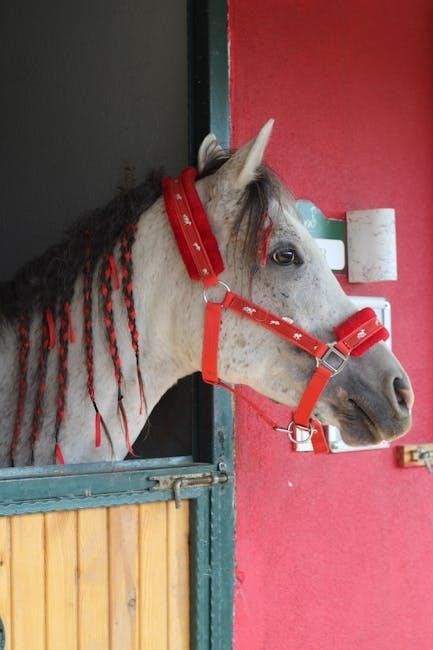Clear livery instructions are essential for ensuring renters understand their responsibilities, facility usage, and safety protocols. They must cover arena access, pasture management, payment terms, and day-to-day horse care procedures.
Importance of Clear Communication
Clear communication is vital to ensure renters understand their responsibilities and facility rules. It prevents misunderstandings, promotes consistency, and maintains safety standards. Renters must be informed about arena usage, grazing policies, and emergency procedures. They should also be aware of payment terms, cancellation policies, and maintenance expectations. Open dialogue fosters a positive environment and ensures smooth day-to-day operations. Regular updates and accessible communication channels help address concerns promptly. Clarity also protects both parties legally by outlining expectations and accountability. Ensuring renters are well-informed creates a respectful and organized livery setup.
Key Areas to Cover in Instructions
Instructions must cover essential aspects of livery management to ensure clarity and compliance. Key areas include facility rules, such as arena usage and pasture access, as well as payment terms and schedules. Renters should be informed about safety protocols, including emergency procedures and equipment maintenance. Day-to-day responsibilities, like feeding schedules and mucking out, must be clearly outlined. Additionally, instructions should address proper handling of livery equipment and adherence to yard etiquette. Insurance requirements and cancellation policies are also crucial to include. By detailing these areas, livery yards can minimize misunderstandings and ensure a smooth, organized operation. Regular updates to the instructions are recommended to reflect any changes in policies or procedures.

Facilities and Services
Livery yards must inform renters about arena usage, pasture access, and facility maintenance schedules. Clear guidelines on service availability and any restrictions ensure smooth operations and resource management.
Understanding Arena Usage and Availability
Liveries must provide clear guidelines on arena usage, including booking procedures, permitted activities, and maintenance schedules. Renters should be informed about restricted times, such as during lessons or events, ensuring fair access for all. Additionally, liveries should outline rules for equipment usage and arena etiquette, like cleaning up after sessions and respecting other users. Availability details, such as seasonal closures for maintenance or weather-related restrictions, should also be communicated. By setting these expectations, liveries can promote a safe, organized, and efficient environment for all renters.
Pasture Management and Grazing Rules
Liveries must instruct renters on pasture management and grazing rules to ensure sustainable use of facilities. This includes rotational grazing schedules, maximum horse numbers per acre, and prohibited practices like overgrazing. Renters should be informed about their responsibilities, such as monitoring horse health, reporting pasture damage, and adhering to fencing and gate protocols. Additionally, liveries should outline rules for supplementary feeding in pastures and the proper disposal of waste. Clear guidelines on pasture maintenance, such as mucking out or repairing fences, should also be provided. By establishing these rules, liveries can protect the land, promote equine welfare, and maintain a balanced ecosystem for all users. Effective communication of these policies ensures long-term sustainability and harmonious yard operations.
Maintenance and Upkeep of Facilities
Liveries must instruct renters on the proper maintenance and upkeep of facilities to ensure longevity and safety. This includes regular cleaning of stables, arenas, and shared areas, as well as reporting any damage or wear and tear. Renters should be informed about their responsibilities in mucking out stalls, refilling water buckets, and disposing of waste correctly. Additionally, liveries should outline schedules for routine inspections of fencing, gates, and equipment to prevent hazards. Clear guidelines on the use of shared tools and machinery, such as tractors or mowers, should also be provided. By emphasizing these maintenance protocols, liveries can ensure a clean, safe, and functional environment for all users. Regular reminders and checklists can help renters stay on track and maintain a well-organized yard.
Safety Protocols
Liveries must instruct renters on emergency procedures, equipment safety checks, and proper handling of livery gear to ensure a safe environment and prevent potential accidents, adhering to all guidelines.
Emergency Procedures and First Aid
Liveries must instruct renters on emergency procedures, including identifying emergency contacts, knowing the location of first aid kits, and understanding fire extinguisher locations. Renters should be trained on basic first aid for both humans and horses, such as wound cleaning and injury assessment. They must also know how to respond to accidents, like falls or equipment malfunctions, and be aware of evacuation routes. Regular drills and updates on safety protocols are crucial. Additionally, renters should be informed about reporting incidents promptly to ensure proper documentation and care. Clear communication of these procedures ensures a safe and prepared environment for all users of the livery facilities.
Equipment Safety Checks and Maintenance
Liveries must instruct renters on the importance of regular equipment safety checks and maintenance. This includes inspecting items like saddles, bridles, and fencing for wear and tear. Renters should be trained to identify and report damaged equipment promptly to prevent accidents. Establishing a maintenance schedule for shared equipment, such as arena machinery or grooming tools, is essential. Clear guidelines on cleaning and storing equipment properly should be provided. Additionally, renters must be informed about protocols for handling and using equipment safely, such as avoiding overloaded fencing or using equipment for its intended purpose. Regular inspections and maintenance ensure the longevity of facilities and the safety of both horses and users. Proper training and adherence to these practices help maintain a secure and functional livery environment.
Proper Handling and Use of Livery Equipment
Liveries must instruct renters on the proper handling and use of all equipment to ensure safety and prevent damage. This includes demonstrating how to correctly use items like lead ropes, saddles, and grooming tools. Renters should be educated on inspecting equipment for damage before use and understanding its intended purpose. Clear guidelines should be provided on how to store equipment properly to maintain its condition. Additionally, renters must be informed about the importance of reporting any misuse of equipment by others. Training sessions or visual aids can help renters understand correct techniques, reducing the risk of accidents or equipment failure. Proper handling ensures the well-being of horses and the longevity of the equipment, fostering a safe and efficient livery environment.
Payment and Contractual Obligations
Liveries must instruct renters on payment terms, schedules, and contractual agreements, ensuring clarity on fees, due dates, and refund policies. Renters should understand cancellation procedures and insurance requirements to avoid disputes.
Payment Terms and Schedules
Liveries must clearly outline payment terms, including due dates, accepted methods, and any late fees. Renters should be informed about invoicing procedures and payment schedules to avoid misunderstandings. Clarity on refund policies and payment plans is crucial. Ensure renters understand how payments correlate to facility access and services provided. Transparent communication about financial obligations helps maintain trust and ensures smooth operations.
Insurance Requirements for Renters
Liveries must specify the insurance requirements for renters to ensure adequate coverage for horses, equipment, and liability. Renters should be informed about the types of insurance needed, such as public liability and equine insurance. Clear guidelines on providing proof of insurance before accessing facilities are essential. Additionally, liveries should outline any specific insurance policies they require, such as coverage for third-party damage or accidents involving rented equipment. Ensuring renters understand and comply with insurance obligations protects both parties and minimizes risks. Regular verification of insurance documents should be part of the agreement to maintain compliance.
Cancellation and Refund Policies
Liveries must clearly outline cancellation and refund policies to avoid disputes. Renters should be informed about the required notice period for terminating the agreement and how refunds are processed. Specific conditions, such as partial refunds for unused services or no refunds for short-notice cancellations, should be detailed. Clarity on whether deposits are refundable or non-refundable is essential. Additionally, liveries should specify if refunds are provided in full, in part, or not at all under certain circumstances. This ensures transparency and sets clear expectations for both parties, reducing the risk of misunderstandings or financial disputes.

Day-to-Day Operations
Liveries must instruct renters on feed management, mucking out schedules, and grooming routines. Clear guidelines ensure horses receive proper care and facilities remain well-maintained.
Feed and Hay Management
Liveries must instruct renters on feed and hay management to ensure horses receive proper nutrition. This includes specifying types of feed allowed, feeding schedules, and storage guidelines.
Renters should be informed about whether hay is provided or if they must source it themselves. Instructions should also cover proper feeding techniques and monitoring for overfeeding or underfeeding.
Clear guidelines on supplement use and handling of feed supplies are essential. Renters must understand the importance of maintaining cleanliness and organization in feed storage areas to prevent contamination.
Additionally, liveries should communicate any specific dietary restrictions or recommendations for individual horses to ensure their health and well-being are prioritized.
Bedding and Mucking Out Responsibilities
Liveries must clearly outline renters’ responsibilities regarding bedding and mucking out to maintain clean and hygienic living conditions for horses. This includes specifying the type of bedding allowed, such as straw or shavings, and the frequency of mucking out.
Renters should be instructed on proper disposal methods for soiled bedding and manure to prevent contamination of pastures and water sources. They must also be informed about the availability of mucking-out tools and storage areas for bedding supplies.
Additionally, liveries should communicate any specific rules about adding extra bedding for horses with special needs or health conditions. Failure to adhere to these responsibilities may result in termination of the agreement.
Clear guidelines ensure the health and well-being of horses while maintaining a clean and organized yard environment.
Exercise and Care Routines for Horses
Liveries must provide renters with detailed guidelines on exercise and care routines to ensure the well-being of horses. This includes specifying feeding times, types of feed allowed, and any supplements that must be approved in advance.
Renters should be instructed on proper grooming practices, such as daily checks for signs of injury or illness, and regular hoof care. Exercise routines must be outlined, including access to arenas, turnout schedules, and any restrictions on overworking horses.
Additionally, liveries should communicate protocols for veterinary care, including approved veterinarians and emergency procedures. Renters must also be informed about mandatory worming schedules and vaccination requirements.
By establishing clear care routines, liveries help ensure horses receive consistent and appropriate attention, promoting their health and safety.

Rules and Regulations
Liveries must instruct renters on yard rules, such as arena usage, guest access, and parking guidelines, ensuring adherence to safety and etiquette standards for a harmonious environment.
Yard Rules and Etiquette
Liveries must instruct renters on maintaining a clean and respectful environment, adhering to noise levels, and proper use of shared facilities. Renters should be informed about rules regarding guest access, parking, and equipment usage. Clear guidelines on tidiness, such as mucking out stalls regularly and disposing of waste correctly, are essential. Safety protocols, like wearing appropriate attire and avoiding reckless behavior, should also be emphasized. Additionally, renters must be advised to respect other users’ space and follow any specific yard routines or restrictions. These instructions ensure a harmonious and safe atmosphere for all. Proper communication of these expectations helps prevent conflicts and maintains the overall condition of the facility.
Visitation and Guest Policies
Liveries must instruct renters on visitation and guest policies to ensure safety and maintain facility order. Renters should be informed that guests must be accompanied and approved in advance. Visitors should be briefed on yard rules, such as wearing appropriate attire and avoiding restricted areas. Renters must ensure guests do not interfere with daily operations or other users. It’s important to specify that guests are not allowed to handle horses or equipment without permission. Additionally, renters should be advised to limit the number of visitors and avoid peak busy times. Clear communication of these policies helps prevent disruptions and ensures a safe environment for everyone. Proper enforcement of these guidelines is essential for maintaining a well-organized and respectful livery yard.
Parking and Vehicle Usage Guidelines
Liveries must provide clear guidelines on parking and vehicle usage to ensure safety and maintain facility access. Renters should be instructed to park in designated areas only and avoid blocking gateways or pathways. Vehicles should not exceed speed limits within the yard, and drivers must be cautious of pedestrians and horses. Renters must also be informed about any restrictions on vehicle types or usage, such as no overnight parking without permission. Additionally, they should be advised to keep vehicles well-maintained to prevent oil leaks or other hazards. Proper signage and communication of these rules help prevent accidents and ensure smooth operations. Compliance with these guidelines is crucial for maintaining a safe and orderly environment for all users of the livery yard.

Communication Channels
Liveries must establish clear communication channels with renters, outlining preferred methods for updates, issue reporting, and scheduling. Regular updates ensure smooth operations and address concerns promptly.
Preferred Methods of Communication
Liveries should specify preferred communication methods, such as email, phone calls, or messaging apps, ensuring renters know the best way to reach staff. Regular updates via newsletters or group chats can keep everyone informed about facility schedules, maintenance, and important notices. It’s crucial to establish a primary contact person for urgent matters. Additionally, liveries may require renters to confirm receipt of important communications to ensure clarity. Open lines of communication help maintain a smooth operation and foster a positive relationship between the livery and its renters. By setting clear expectations, liveries can avoid misunderstandings and ensure all parties are aligned on key issues.
Reporting Issues or Concerns
Liveries must instruct renters on proper procedures for reporting issues or concerns, such as facility damage or horse health problems. Renters should be informed of a clear reporting process, including who to contact and how to document issues. This ensures timely resolution and maintains the safety and well-being of both horses and facilities. Regular inspections and an open-door policy encourage renters to voice concerns without hesitation. By establishing a structured reporting system, liveries can address problems efficiently, preventing minor issues from escalating. Clear communication channels and a proactive approach foster a responsible and collaborative environment for all parties involved.
Scheduling and Coordination
Liveries must instruct renters on proper scheduling and coordination procedures to ensure smooth operations. This includes advance booking for arena or facility usage, shared calendars for lesson times, and coordination for vet or farrier visits. Renters should be informed of time slots for horse care routines and equipment usage to avoid conflicts. Clear guidelines on rescheduling or canceling appointments are essential to maintain order. Liveries should also outline expectations for communication regarding changes in schedules or special requests. By emphasizing the importance of punctuality and respect for shared resources, liveries can foster a harmonious environment. Regular updates to schedules and reminders should be provided to keep everyone informed. Proper scheduling ensures efficient use of facilities and supports the overall well-being of the horses and the operation.

Termination of Agreement
Liveries must instruct renters on termination procedures, including notice periods, returning facilities and equipment, and final payment settlements to ensure a smooth and orderly agreement conclusion.
Notice Periods and Procedures
Livery yards must clearly outline termination notice periods, typically ranging from 30 to 90 days, and specify how renters should formally notify the yard. Renters must understand the required timeline for vacating premises and returning equipment. Procedures should include submitting written notice, ensuring all payments are up to date, and arranging a final inspection of facilities. The livery should also detail any penalties for early termination or failure to adhere to the notice period. Clear communication ensures a smooth transition and prevents disputes. Proper documentation and acknowledgment of the termination process are essential for both parties.
Return of Facilities and Equipment
Livery instructions must specify that renters are responsible for returning all facilities and equipment in good condition upon termination. This includes cleaning and maintaining arenas, stables, and pastures to the standard they were in upon arrival. Renters must ensure all borrowed equipment, such as tack, tools, or machinery, is accounted for and returned. Facilities should be free of rubbish and damage, with any repairs or replacements addressed before departure. A final inspection is often required to confirm compliance. Renters who fail to meet these obligations may face additional charges or deductions from their deposits. Clear instructions help ensure a smooth transition and protect both parties from potential disputes.
Final Payment and Settlement
Livery instructions must outline the process for final payment and settlement upon termination of the agreement. Renters should be informed of the required payment deadline and acceptable payment methods. Any outstanding fees, including late payments, must be clearly stated. Instructions should also detail how invoices will be issued and how payments will be applied. Renters must be notified about potential deductions for damages or missing items. If applicable, refund processes for deposits or unused services should be explained. The livery should also specify how financial records will be provided for transparency. Clear instructions ensure a smooth financial conclusion, protecting both the livery and renters from disputes. Proper documentation is essential to confirm all obligations are met.